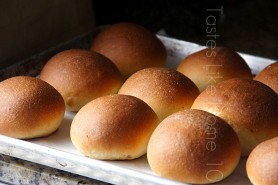 Hi Everyone, Each Caribbean nation has its signature bread-roll with its one-of-a-kind flavour and texture. Trinidad and Tobago has Hops Bread, Jamaica has Coco Bread, Barbados has Salt Bread and Guyana has Tennis Rolls. Many of us living away from home try to acquire recipes to recreate these unique tastes of home. Alas, while we may get something resembling the real thing in appearance and flavour, the real thing eludes us. Such is the case with the Tennis Roll; so called because of its perfectly round shape.
Hi Everyone, Each Caribbean nation has its signature bread-roll with its one-of-a-kind flavour and texture. Trinidad and Tobago has Hops Bread, Jamaica has Coco Bread, Barbados has Salt Bread and Guyana has Tennis Rolls. Many of us living away from home try to acquire recipes to recreate these unique tastes of home. Alas, while we may get something resembling the real thing in appearance and flavour, the real thing eludes us. Such is the case with the Tennis Roll; so called because of its perfectly round shape.
For a long time now, I (and countless others) have been trying to locate a recipe for Tennis Rolls without much success. I thought that I was close when I met one of the owners of the defunct Fung’s Bakery whilst on a visit to Barbados, but no such luck. However, I did get some fleeting insights into the complexity of making this much beloved roll. I resigned myself to thinking that one day when the time was right, the recipe would be shared and hopefully, I’d have the equipment necessary to make Tennis Rolls.

So when I received an email from a regular reader of my column and blog, who has been living abroad for more than 30 years, telling me that she had found a recipe online for Tennis Rolls and that, “It was the authentic thing and surprisingly very simple”, I knew I had to give it a try. I was skeptical, but the thing is, you just never know. I had a few articles to write that day and several assignments to grade but like I said a few weeks
ago, when I want to avoid work, I bake. So I set about trying this Tennis Rolls recipe.
I am not a big bread lover but visions of a warm, hearty Tennis Roll, sliced in half and protecting thick slices of cheddar cheese was more than enough to motivate me. To wash it down, an ice-cold glass of cream soda made creamy with carnation milk. Ooo la la! Childhood memories of this after school snack thrilled me. My dear aunt, Betty, loves this combo too. My mom is not a big bread lover either; she prefers salt biscuits with cheese along with the cream soda and milk. But I digress.

I am not going to spend time telling you about the process of making the Tennis Rolls, let me cut to the chase and give you my verdict.
● The rolls looked exactly like Tennis Rolls –
perfectly round and impeccably browned.
● The rolls smelt exactly like Tennis Rolls – bready and sweet .
● The rolls had the flavour of Tennis Rolls – sweet and with the orange
zest giving it that signature taste.
● The rolls did not feel like Tennis Rolls – they felt a little too soft but the next
day, they had that give that a Tennis Roll has when you press it. It bounces back.
● The rolls did not have the texture of Tennis Rolls – the crumb was not as
uniform and compact as Tennis Rolls.
● Overall – It is an excellent roll and the closest that one can come to making
Tennis Rolls at home but Tennis Rolls aficionados will tell you that’s not
Tennis Rolls.
I am not an expert baker, but based on what I have experienced, read and discussed about baking, I am pretty confident that the main “problem” area with the rolls – the texture when it is felt and the crumb – could be as a result of the amount of liquid in the dough and a lack of the kind of kneading/handling of the dough that is required for real Tennis Rolls. Let me explain.
First, you need to understand what the term “crumb” means.
Crumb is a term used to define the inside of bread – the “meat” of the bread so to speak. That is where you can see the holes in the bread, whether they are compact and uniform or airy and tender or if there are large holes. Experienced bakers can tell just by looking at the crumb, the hydration in the bread (amount of water in the dough), types of flour and yeast amounts as well as how the dough was mixed and shaped.
Hydration refers to the amount of water in a dough. And the amount of water in the dough defines the type of bread the dough will make. The more water (liquid) added to the dough results in the hole-structure of the crumb getting larger and more irregular. The less liquid, the tighter the crumb and the more uniform it looks. The recipe I used for these “Tennis Rolls” called for a lot of liquid and this resulted in an airy, light texture with a crumb not as compact or uniform as traditional Tennis Rolls.
Another key area that would affect the home baker from recreating real Tennis Rolls would have to be the mixing method. In other words, the kneading method. You see, in professional bread baking, there are three types of mixing methods that may be used – the intensive method, the improved method and the simplified method. Each method has its advantages depending on the type of dough being made. (Reinhart 2001). Sweet dough – the dough for Tennis Rolls is sweet – usually requires a long intensive mixing on high speed to accomplish fat incorporation and for the gluten to fully develop. I kneaded my dough by hand for 10 minutes but I am sure that the bakers at all the bakeries that make Tennis Rolls will tell you that the dough is kneaded for much longer, by mixers and at a high speed.
The shaping of the rolls is another important area that could affect the outcome of the Tennis Rolls. Shaping is another opportunity to work the dough into the shapes required for baking. In this case, the cut pieces of dough were made into balls. The dough-balls should be compact, I tried making them as compact as I could by hand. In a commercial bakery, a machine would do this expertly with the precise amount of intensity, an intensity that cannot necessarily be replicated in a home kitchen.
As I’ve said before, the rolls I made are excellent rolls though they are not the real Tennis Rolls. But you know what? I had mine with slices of cheese and chased down with ice-cold cream soda and milk, just like I used to when I’d return from school in the afternoons. Another taste of home – done! Thanks for the nudge Melissa.
Cynthia
Homemade Tennis Rolls
(Adapted from Jennifer Szala Snyder)
Yield: 24 – 26 large rolls
- Ingredients
1 cup whole milk, scalded (when bubbles form around the edges)
¼ cup unsalted butter (2 oz)
1 cup white granulated sugar
1 teaspoon table salt
2 teaspoons orange or lemon zest
1 teaspoon lemon extract (or essence)
1 teaspoon vanilla extract (or essence)
2 eggs plus 1 egg yolk, beaten
1 package instant yeast (11 grams or 3 ¼ teaspoons)
¼ cup warm water (110 degrees F)
5 cups all purpose flour plus extra for work surface and kneading
Directions
1. Add the butter, sugar, salt, zest and extracts/essences to the scalded milk and stir to mix and dissolve sugar. Set aside and cool until warm (110 degrees F).
2. Dissolve yeast in water.
3. In a large bowl, pour in warm milk mixture along with eggs and yeast; mix thoroughly.
4. Add 2 cups of flour to the wet ingredients and mix to make a smooth batter. Let mixture rest uncovered for 6 minutes.
5. Gradually add the remaining flour to the mixture, ½ cup at a time until a dough forms.
6. Flour a work surface and transfer the dough onto the work surface and start kneading the dough, dusting with more flour. The dough will be sticky at first but the more you knead and dust with flour it will become uniform. Knead dough for 10 minutes or until it becomes smooth and elastic.
7. Place the dough in an oiled bowl. Dab a little oil on top of the dough to avoid it forming a skin. Cover with plastic wrap and place in a warm, draft free area to proof until doubled in size; about 2 hours (this will depend on your location and the warmth of the environment).
8. Turn dough onto work surface, the gas should escape naturally, deflating the dough (this is called punched down).
9. Cut the dough into equal pieces; I usually weigh my dough for uniformity and even baking.
10. Form each cut piece of dough into a compact ball and place on parchment-lined baking sheets. Cover with plastic wrap, place them somewhere warm and draft free and let rise for 45 minutes to 1 hour.
11. 20 minutes before the second-rising time is up, preheat your oven to 375 degrees F. Bake rolls for 12 – 14 minutes or until evenly browned.
12. Transfer to wire racks and cool. Serve at room temperature.
Elusive Tennis Rolls








